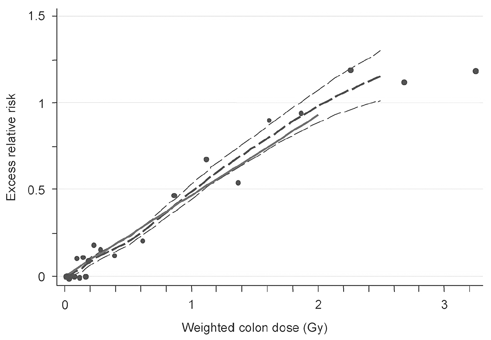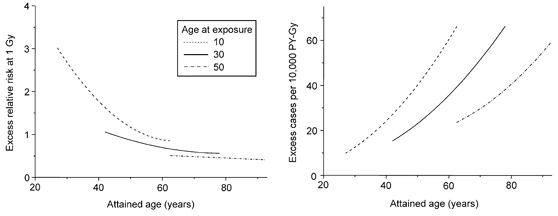Solid Cancer Risks among Atomic-bomb Survivors
Increased risk of cancer is the most important late effect of radiation exposure seen in A-bomb survivors. For cancers other than leukemia (solid cancers), excess risk associated with radiation started to appear about ten years after exposure. This was first noted by a Japanese physician, Gensaku Obo, in 1956, and it led to continuing comprehensive analyses of cancer mortality and to the creation of tumor registries by the city medical associations in both Hiroshima and Nagasaki.
For most solid cancers, acute radiation exposure at any age increases one’ s cancer risk for the rest of life. As survivors have aged, radiation-associated excess rates of solid cancer have increased as well as the background rates. For the average radiation exposure of survivors within 2,500 meters (about 0.2 Gy), the increase is about 10% above normal age-specific rates. For a dose of 1.0 Gy, the corresponding cancer excess is about 50% (relative risk = 1.5).
Tumor registries were initiated in 1957 in Hiroshima and 1958 in Nagasaki. During the period from 1958 to 1998, 7,851 malignancies (first primary) were observed among 44,635 LSS survivors with estimated doses of >0.005 Gy. The excess number of solid cancers is estimated as 848 (10.7%) (Table). The dose-response relationship appears to be linear, without any apparent threshold below which effects may not occur (Figure 1).
Table. Excess risk of developing solid cancers in LSS, 1958-1998
|
||||||||||||||||||||||||||||||||||||
|
||||||||||||||||||||||||||||||||||||

Figure 1. LSS solid cancer incidence, excess relative risk by radiation dose, 1958-1998. The thick solid line is the fitted linear sex-averaged excess relative risk (ERR) dose response at age 70 after exposure at age 30. The thick dashed line is a non-parametric smoothed estimate of the dose category-specific risks and the thin dashed lines are one standard error above and below this smoothed estimate.
The probability that an A-bomb survivor will have a cancer caused by A-bomb radiation (excess lifetime risk) depends on the dose received, age at exposure, and sex. Figure 2 represents excess relative risk and excess absolute risk (sex-averaged) exposed to 1 Gy. Both expressions of excess risk indicate that higher risks are associated with younger age at exposure. Other analyses (not shown) indicate that females have somewhat higher risks of cancer from radiation exposure than males do.

Figure 2. Effects of age at exposure and attained age on the excess risk of solid cancer (incidence) following exposure to 1 Gy. The left panel represents excess relative risk (ERR) and the right panel excess absolute risk (EAR).

